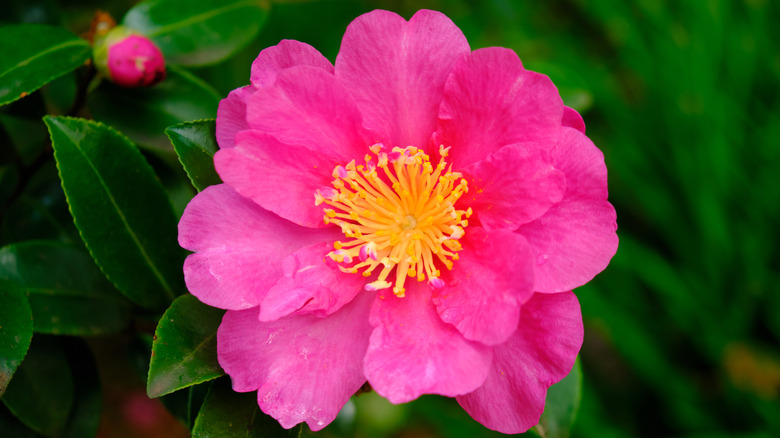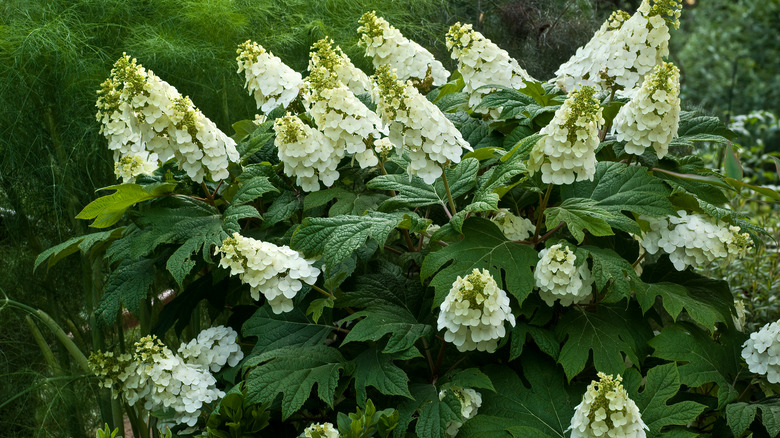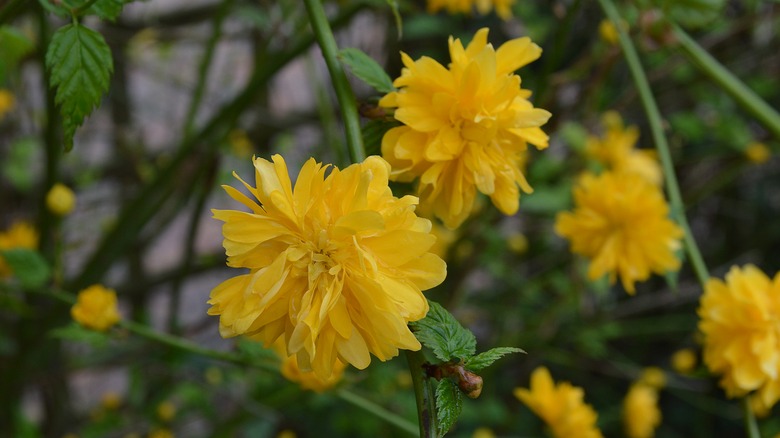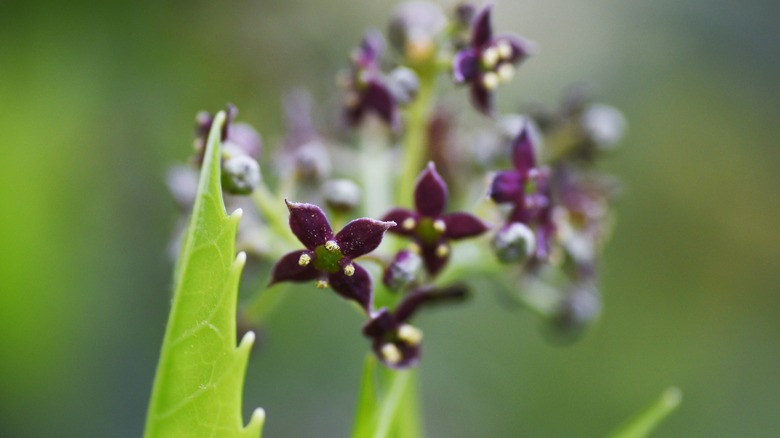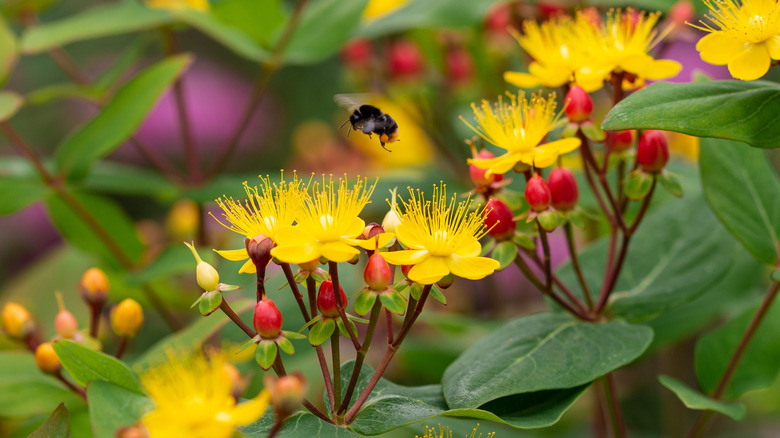15 Gorgeous Flowering Shrubs That Thrive In The Shade
Many of the most beautiful plants we want in our gardens are sun lovers that require warm temperatures, dry soil, and consistent sunlight. Tropical plants with large blooms and bright foliage typically cannot survive in shaded sites that force them to lose their leaves or produce fewer flowers. Not only does the light become a problem, but shaded areas of your garden usually have poor and moist soil, cooler temperatures, and competition from larger plants such as trees. While this is a death sentence for drought-tolerant, warm-weather plants, it is the perfect environment for flowering shrub species such as hydrangeas, Diervilla, and dogwood, according to the University of Minnesota Extension.
Creating a garden in the shade, especially one that shows off gorgeous flowers, can be a challenge. You must choose the right plants for the job or else you will be left with leggy, non-flowering, and dying bushes, flowers, and groundcovers that only make the shaded parts of your garden even less welcoming. Here, we have done our research and found many of the best shade-tolerant shrubs that will flower each year beneath structures or tall trees.
1. Flame azalea
Flame azalea (Rhododendron calendulaceum) is an adaptable shrub that may be grown in several different sun, soil, and weather conditions. North Carolina State Extension notes that this tall-growing shrub is frequently planted in a spring garden. Its large red, orange, yellow, or pink blooms bring forth bright color in the sun or shade.
Bloom Season: Spring
USDA Growing Zone: 5 to 7
Growing Conditions: Full sun to full shade
Soil Type: Well-draining
Size: Up to 15 feet tall and 10 feet wide
2. Sasanqua camellia
The sasanqua camellia bush (Camellia sasanqua) is a broadleaf evergreen shrub that shows off dark green leaves and fragrant red blossoms that persist from fall to the beginning of winter, as per Oregon State University. Though the plant grows best in partial shade, it should not be planted in USDA zones below seven. It needs mild winters and warm weather during the spring and summer.
Bloom Season: Fall to early winter
USDA Growing Zone: 7 to 9
Growing Conditions: Partial shade
Soil Type: Organically rich, moist, and well-draining
Size: 6 to 10 feet tall
3. Bottlebrush buckeye
The bottlebrush buckeye (Aesculus parviflora) is named after its large spikes of flowers that bloom above its foliage. These flower clusters are almost always white, and they appear fluffy from a distance, as said by The Morton Arboretum. The shrub thrives in partial shade, but it needs a bit of sunlight to flower properly.
Bloom Season: Summer
USDA Growing Zone: 4 to 8
Growing Conditions: Partial shade
Soil Type: Well-draining soil
Size: More than 8 feet tall
4. Winter daphne
Winter daphne (Daphne odora), which is native to China and Japan, blooms in the spring with clusters of white and red to purple flowers among long, glossy leaves. Missouri Botanical Garden points out that these flowers are fragrant and last from January to March. In the summer, the blooms give way to red berries that are not edible.
Bloom Season: Spring
USDA Growing Zone: 7 to 9
Growing Conditions: Partial shade
Soil Type: Rich, moist and well-draining
Size: 3 to 4 feet tall and 2 to 4 feet wide
5. Possumhaw viburnum
Possumhaw viburnum (Viburnum nudum) is known for its clusters of tiny white flowers with a sweet scent. The shrub attracts a few different pollinators such as bees, birds, and butterflies. Jersey-Friendly Yards suggests planting this flowering bush in partial shade or full shade for the best results.
Bloom Season: Spring and summer
USDA Growing Zone: 6 to 7
Growing Conditions: Partial shade to full shade
Soil Type: Well-draining
Size: 5 to 6 feet tall
6. Smooth hydrangea
Smooth hydrangea (Hydrangea arborescens), also known as wild hydrangea, is a cold hardy plant that produces large clusters of flowers that can be white, green, or pink, states North Carolina State Extension. The bush grows best in partial shade. Though it can be grown in full sun, the conditions may cause it to lose foliage due to dry soil. Smooth hydrangeas are very intolerant of drought.
Bloom Season: Spring and summer
USDA Growing Zone: 3 to 9
Growing Conditions: Partial shade
Soil Type: Moist and well-draining
Size: 3 to 5 feet tall and wide
7. Japanese Pieris
Japanese Pieris (Pieris japonica), also called Japanese Andromeda, grows well nearby tall buildings and other structures that provide it with some sunlight and shade. Oregon State University recommends several Japanese Pieris cultivars that boast clusters of flowers in shades of red, pink, and white. These clusters hang down away from the foliage of the plant, which gives it a unique look throughout the spring.
Bloom Season: Spring
USDA Growing Zone: 5 to 9
Growing Conditions: Partial shade
Soil Type: Rich, moist, acidic, and well-draining
Size: 9 to 12 feet tall and 6 to 8 feet wide
8. Oakleaf hydrangea
The oakleaf hydrangea (Hydrangea quercifolia) is a shade-loving, flowering bush that needs little maintenance once it is established. Typically, this deciduous and multi-stemmed plant grows to 8 feet tall and wide, so be sure to plant it in an area where it can spread as it grows. Clemson University mentions that the oakleaf hydrangea bush grows best in southern states such as Florida, Georgia, Tennessee, Alabama, and Louisiana.
Bloom Season: Summer to winter
USDA Growing Zone: 5 to 9
Growing Conditions: Partial to full shade
Soil Type: Fertile and well-draining
Size: 6 to 8 feet tall and wide
9. Japanese rose tree
The Japanese rose tree (Kerria japonica) is a unique flowering shrub that is most often used in partially shaded gardens. As per Clemson Cooperative Extension, the Japanese rose tree is considered a small ornamental shrub, but it can grow as large as 8 feet tall depending on the cultivar. Shorter cultivars, however, such as the 'Golden Guinea' variety, reach only 5 feet tall.
Bloom Season: Early spring
USDA Growing Zone: 4 to 9
Growing Conditions: Partial shade
Soil Type: Rich and well-draining
Size: 3 to 8 feet tall
10. Spotted laurel
The spotted laurel (Aucuba japonica) is a flowering shrub that thrives in partial or full shade. In the spring, this plant produces fragrant, dark purple flowers that show off four or five pointed petals. Later, the flowers give way to red berries that will brighten your garden in the winter. Oregon State University notes that the spotted laurel is most often grown for its variegated leaves; however, the flowers and fruit are still ornamental.
Bloom Season: Spring
USDA Growing Zone: 6 to 9
Growing Conditions: Partial to full shade
Soil Type: Well-draining
Size: 6 to 10 feet tall
11. Hypericum
Hypericum (Hypericum androsaemum), which is also frequently referred to as sweet amber, is recognized for its clusters of yellow flowers that bloom in full sun or partial shade. The plant, which is well-known for its shade tolerance, according to Missouri Botanical Garden, also produces red to black fruits after its bloom season in the summer.
Bloom Season: Spring to summer
USDA Growing Zone: 5 to 8
Growing Conditions: Partial shade
Soil Type: Well-draining
Size: 2 to 3 feet tall and wide
12. Mountain laurel
Mountain laurel (Kalmia latifolia) can be identified by its rounded shape, glossy dark green foliage, and spring-blooming flowers, as said by the University of Connecticut. The shrub can grow in full shade; however, it will bloom more profusely if it is planted where it will receive some sunlight. In direct sun exposure, the foliage may change color or it can burn if it's too intense.
Bloom Season: Spring
USDA Growing Zone: 4 to 9
Growing Conditions: Full sun, partial shade, or full shade
Soil Type: Rich, moist, and acidic
Size: 5 to 12 feet tall and wide
13. Northern bush honeysuckle
Northern bush honeysuckle (Diervilla lonicera) boasts green foliage that can shift to orange, yellow, or purple as the seasons change. Prairie Nursery notes that these colors are most obvious when the bush is planted in the sun; however, the flowers it produces in the summer are not affected by this. In partial shade, the Diervilla species shows off yellow and orange clusters of flowers that are loved by pollinators and gardeners alike.
Bloom Season: Summer
USDA Growing Zone: 3 to 10
Growing Conditions: Partial shade
Soil Type: Rocky and well-draining
Size: 1 to 3 feet tall
14. Slender deutzia
Slender deutzia (Deutzia gracilis), as warned by Missouri Botanical Garden, has foliage that can be bleached to white in direct sunlight. It's in a gardener's best interest that this member of the Hydrangeaceae family is planted in some shade so the leaves of the plant stay green. Though the slender deutzia shrub can be planted in full shade, it does need some sunlight to flower with fragrant white blossoms in the spring.
Bloom Season: Spring
USDA Growing Zone: 5 to 8
Growing Conditions: Partial shade
Soil Type: Moist and well-draining
Size: 2 to 5 feet tall and wide
15. Virginia sweetspire
Virginia sweetspire (Itea virginica) is an adaptable and pollinator-friendly shrub that is native to North America. The flowering plant can be grown in a range of sunlight and soil conditions. It is a wonderful addition to any garden that needs bright and fragrant flowers. Proven Winners says that the Virginia sweetspire shrub can be massed in beds and borders or planted in a medium or large container.
Bloom Season: Summer to fall
USDA Growing Zone: 5 to 9
Growing Conditions: Full sun to full shade
Soil Type: Well-draining
Size: 2 to 3 feet tall and wide


